- Home
- Isaac Asimov
Asimov’s Future History Volume 4 Page 4
Asimov’s Future History Volume 4 Read online
Page 4
Baley said as he entered, “Damn it, Commissioner, don’t send that thing after me, will you?”
But the Commissioner only said, “Sit down, Lije. Sit down.”
Baley sat down and stared. Perhaps he had done old Julius an injustice. Perhaps the man hadn’t slept after all. He looked fairly beat.
The Commissioner was tapping the paper before him. “There’s a record of a call you made to a Dr. Gerrigel at Washington by insulated beam.”
“That’s right, Commissioner.”
“There’s no record of the conversation, naturally, since it was insulated. ‘What’s it all about?”
“I’m after background information.”
“He’s a roboticist, isn’t he?”
“That’s right.”
The Commissioner put out a lower lip and suddenly looked like a child about to pout. “But what’s the point? What kind of information are you after?”
“I’m not sure, Commissioner. I just have a feeling that in a case like this, information on robots might help.” Baley clamped his mouth shut after that. He wasn’t going to be specific, and that was that.
“I wouldn’t, Lije. I wouldn’t. I don’t think it’s wise.”
“What’s your objection, Commissioner?”
“The fewer the people who know about all this, the better.”
“I’ll tell him as little as I can. Naturally.”
“I still don’t think it’s wise.”
Baley was feeling just sufficiently wretched to lose patience.
He said, “Are you ordering me not to see him?”
“No. No. You do as you see fit. You’re heading this investigation. Only..
“Only what?”
The Commissioner shook his head. “Nothing.–Where is he? You know who I mean.”
Baley did. He said, “Daneel’s still at the files.”
The Commissioner paused a long moment, then said, “We’re not making much progress, you know.”
“We’re not making any so far. Still, things may change.”
“All right, then,” said the Commissioner, but he didn’t look as though he really thought it were all right.
R. Daneel was at Baley’s desk, when the latter returned.
“Well, and what have you got?” Baley asked gruffly.
“I have completed my first, rather hasty, search through the files, partner Elijah, and I have located two of the people who tried to track us last night and who, moreover, were at the shoe store during the former incident.”
“Let’s see.”
R. Daneel placed the small, stamp-size cards before Baley. They were mottled with the small dots that served as code. The robot also produced a portable decoder and placed one of the cards into an appropriate slot. The dots possessed electrical conduction properties different from that of the card as a whole. The electric field passing through the card was therefore distorted in a highly specific manner and in response to that specification the three-by-six screen above the decoder was filled with words. Words which, uncoded, would have filled several sheets of standard size report paper. Words, moreover, which could not possibly be interpreted by anyone not in possession of an official police decoder.
Baley read through the material stolidly. The first person was Francis Clousarr, age thirty-three at time of arrest two years before; cause of arrest, inciting to riot; employee at New York Yeast; home address, so-and-so; parentage, so-and-so; hair, eyes, distinguishing marks, educational history, employment history, psychoanalytic profile, physical profile, data here, data there, and finally reference to the photo in the rogues’ gallery.
“You checked the photograph?” asked Baley.
“Yes, Elijah.”
The second person was Gerhard Paul. Baley glanced at the material on that card and said, “This is all no good.”
R. Daneel said, “I am sure that cannot be so. If there is an organization of Earthmen who are capable of the crime we are investigating, these are members. Is that not an obvious likelihood? Should they then not be questioned?”
“We’d get nothing out of them.”
“They were there, both at the shoe store and in the kitchen. They cannot deny it.”
“Just being there’s no crime. Besides which, they can deny it. They can just say they weren’t there. It’s as simple as that. How can we prove they’re lying?”
“I saw them.”
“That’s no proof,” said Baley, savagely. “No court, if it ever came to that, would believe that you could remember two faces in a blur of a million.”
“It is obvious that I can.”
“Sure. Tell them what you are. As soon as you do that, you’re no witness. Your kind have no status in any court of law on Earth.”
R. Daneel said, “I take it, then, that you have changed your mind.”
“What do you mean?”
“Yesterday, in the kitchen, you said there was no need to arrest them. You said that as long as I remembered their faces, we could arrest them at any time.”
“Well, I didn’t think it through,” said Baley. “I was crazy. It can’t be done.”
“Not even for psychological reasons? They would not know we had no legal proof of their complicity in conspiracy.”
Baley said, tensely, “Look, I am expecting Dr. Gerrigel of Washington in half an hour. Do you mind waiting till he’s been here and gone? Do you mind?”
“I will wait,” said R. Daneel.
Anthony Gerrigel was a precise and very polite man of middle height, who looked far from being one of the most erudite roboticists on Earth. He was nearly twenty minutes late, it turned out, and quite apologetic about it. Baley, white with an anger born of apprehension, shrugged off the apologies gracelessly. He checked his reservation on Conference Room D, repeated his instructions that they were not to be disturbed on any account for an hour, and led Dr. Gerrigel and R. Daneel down the corridor, up a ramp, and through a door that led to one of the spy-beam-insulated chambers.
Baley checked the walls carefully before sitting down, listening to the soft burr of the pulsometer in his hand, waiting for any fading of the steady sound which would indicate a break, even a small one, in the insulation. He turned it on the ceiling, floor, and, with particular care, on the door. There was no break.
Dr. Gerrigel smiled a little. He looked like a man who never smiled more than a little. He was dressed with a neatness that could only be described as fussy. His iron-gray hair was smoothed carefully back and his face looked pink and freshly washed. He sat with a posture of prim stiffness as though repeated maternal advice in his younger years concerning the desirability of good posture had rigidified his spine forever.
He said to Baley, “You make this all seem very formidable.”
“It’s quite important, Doctor. I need information about robots that only you can give me, perhaps. Anything we say here, of course, is top secret and the City will expect you to forget it all when you leave.” Baley looked at his watch.
The little smile on the roboticist’s face winked away. He said, “Let me explain why I am late.” The matter obviously weighed upon him. “I decided not to go by air. I get airsick.”
“That’s too bad,” said Baley. He put away the pulsometer, after checking its standard settings to make last-minute certain that there was nothing wrong with it, and sat down.
“Or at least not exactly airsick, but nervous. A mild agoraphobia. It’s nothing particularly abnormal, but there it is. So I took the expressways.”
Baley felt a sudden sharp interest. “Agoraphobia?”
“I make it sound worse than it is,” the roboticist said at once. “It’s just the feeling you get in a plane. Have you ever been in one, Mr. Baley?”
“Several times.”
“Then you must know what I mean. It’s that feeling of being surrounded by nothing; of being separated from–from empty air by a mere inch of metal. It’s very uncomfortable.”
“So you took the expressway?”
“Yes.”
“All the way from Washington to New York?”
“Oh, I’ve done it before. Since they built the Baltimore-Philadelphia tunnel, it’s quite simple.”
So it was. Baley had never made the trip himself, but he was perfectly aware that it was possible. ‘Washington, Baltimore, Philadelphia, and New York had grown, in the last two centuries, to the point where all nearly touched. The Four-City Area was almost the official name for the entire stretch of coast, and there were a considerable number of people who favored administrational consolidation and the formation of a single super-City. Baley disagreed with that, himself. New York City by itself was almost too large to be handled by a centralized government. A larger City, with over fifty million population, would break down under its own weight.
“The trouble was,” Dr. Gerrigel was saying, “that I missed a connection in Chester Sector, Philadelphia, and lost time. That, and a little difficulty in getting a transient room assignment, ended by making me late.”
“Don’t worry about that, Doctor. What you say, though, is interesting. In view of your dislike for planes, what would you say to going outside City limits on foot, Dr. Gerrigel?”
“For what reason?” He looked startled and more than a little apprehensive.
“It’s just a rhetorical question. I’m not suggesting that you really should. I want to know how the notion strikes you, that’s all.”
“It strikes me very unpleasantly.”
“Suppose you had to leave the City at night and walk cross country for half a mile or more.”
“I–I don’t think I could be persuaded to.”
“No matter how important the necessity?”
“If it were to save my life or the lives of my family, I might try....” He looked embarrassed. “May I ask the point of these questions, Mr. Baley?”
“I’ll tell you. A serious crime has been committed, a particularly disturbing murder. I’m not at liberty to give you the details. There is a theory, however, that the murderer, in order to commit the crime, did just what we were discussing; he crossed open country at night and alone. I was just wondering what kind of man could do that.”
Dr. Gerrigel shuddered. “No one I know. Certainly not I. Of course, among millions I suppose you could find a few hardy individuals.”
“But you wouldn’t say it was a very likely thing for a human being to do?”
“No. Certainly not likely.”
“In fact, if there’s any other explanation for the crime, any other conceivable explanation, it should be considered.”
Dr. Gerrigel looked more uncomfortable than ever as he sat bolt upright with his well-kept hands precisely folded in his lap. “Do you have an alternate explanation in mind?”
“Yes. It occurs to me that a robot, for instance, would have no difficulty at all in crossing open country.”
Dr. Gerrigel stood up. “Oh, my dear sir!”
“What’s wrong?”
“You mean a robot may have committed the crime?”
“Why not?”
“Murder? Of a human being?”
“Yes. Please sit down, Doctor.”
The roboticist did as he was told. He said, “Mr. Baley, there are two acts involved: walking cross country, and murder. A human being could commit the hatter easily, but would find difficulty in doing the former. A robot could do the former easily, but the latter act would be completely impossible. If you’re going to replace an unlikely theory by an impossible one–”
“Impossible is a hell of a strong word, Doctor.”
“You’ve heard of the First Law of Robotics, Mr. Baley?”
“Sure. I can even quote it: A robot may not injure a human being, or, through inaction, allow a human being to come to harm.” Baley suddenly pointed a finger at the roboticist and went on, “Why can’t a robot be built without the First Law? What’s so sacred about it?”
Dr. Gerrigel looked startled, then tittered, “Oh, Mr. Baley.”
“Well, what’s the answer?”
“Surely, Mr. Baley, if you even know a little about robotics, you must know the gigantic task involved, both mathematically and electronically, in building a positronic brain.”
“I have an idea,” said Baley. He remembered well his visit to a robot factory once in the way of business. He had seen their library of bookfilms, long ones, each of which contained the mathematical analysis of a single type of positronic brain. It took more than an hour for the
average such film to be viewed at standard scanning speed, condensed though its symbolisms were. And no two brains were alike, even when prepared according to the most rigid specifications. That, Baley understood, was a consequence of Heisenberg’s Uncertainty Principle. This meant that each film had to be supplemented by appendices involving possible variations.
Oh, it was a job, all right. Baley wouldn’t deny that.
Dr. Gerrigel said, “Well, then, you must understand that a design for a new type of positronic brain, even one where only minor innovations are involved, is not the matter of a night’s work. It usually involves the entire research staff of a moderately sized factory and takes anywhere up to a year of time. Even this large expenditure of work would not be nearly enough if it were not that the basic theory of such circuits has already been standardized and may be used as a foundation for further elaboration. The standard basic theory involves the Three Laws of Robotics: the First Law, which you’ve quoted; the Second Law, which states, ‘A robot must obey the orders given it by human beings except where such orders would conflict with the First Law,’ and the Third Law, which states, ‘A robot must protect its own existence as long as such protection does not conflict with the First or Second Law.’ Do you understand?”
R. Daneel, who, to all appearances, had been following the conversation with close attention, broke in. “If you will excuse me, Elijah, I would like to see if I follow Dr. Gerrigel. What you imply, sir, is that any attempt to build a robot, the working of whose positronic brain is not oriented about the Three Laws, would require first the setting up of a new basic theory and that this, in turn, would take many years.”
The roboticist looked very gratified. “That is exactly what I mean, Mr...”
Baley waited a moment, then carefully introduced R. Daneel: “This is Daneel Olivaw, Dr. Gerrigel.”
“Good day, Mr. Olivaw.” Dr. Gerrigel extended his hand and shook Daneel’s. He went on, “It is my estimation that it would take fifty years to develop the basic theory of a non-Asenion positronic brain–that is, one in which the basic assumptions of the Three Laws are disallowed–and bring it to the point where robots similar to modern models could be constructed.”
“And this has never been done?” asked Baley. “I mean, Doctor, that we’ve been building robots for several thousand years. In all that time, hasn’t anybody or any group had fifty years to spare?”
“Certainly,” said the roboticist, “but it is not the sort of work that anyone would care to do.”
“I find that hard to believe. Human curiosity will undertake anything.”
“It hasn’t undertaken the non-Asenion robot. The human race, Mr. Baley, has a strong Frankenstein complex.”
“A what?”
“That’s a popular name derived from a Medieval novel describing a robot that turned on its creator. I never read the novel myself. But that’s beside the point. What I wish to say is that robots without the First Law are simply not built.”
“And no theory for it even exists?”
“Not to my knowledge, and my knowledge,” he smiled self-consciously, “is rather extensive.”
“And a robot with a First Law built in could not kill a man?”
“Never. Unless such killing were completely accidental or unless it were necessary to save the lives of two or more men. In either case, the positronic potential built up would ruin the brain past recovery.”
“All right,” said Baley. “All this represents the situation on Earth. Right?”
; “Yes. Certainly.”
“What about the Outer Worlds?”
Some of Dr. Gerrigel’s self-assurance seemed to ooze away. “Oh dear, Mr. Baley, I couldn’t say of my own knowledge, but I’m sure that if non-Asenion positronic brains were ever designed or if the mathematical theory were worked out, we’d hear of it.”
“Would we? Well, let me follow up another thought in my mind, Dr. Gerrigel. I hope you don’t mind.”
“No. Not at all.” He looked helplessly first at Baley, then at R. Daneel. “After all, if it is as important as you say, I’m glad to do all I can.”
“Thank you, Doctor. My question is, why humanoid robots? I mean that I’ve been taking them for granted all my life, but now it occurs to me that I don’t know the reason for their existence. Why should a robot have a head and four limbs? Why should he look more or less like a man?”
“You mean, why shouldn’t he be built functionally, like any other machine?”
“Right,” said Baley. “Why not?”
Dr. Gerrigel smiled a little. “Really, Mr. Baley, you are born too late. The early literature of robotics is riddled with a discussion of that very matter and the polemics involved were something frightful. If you would like a very good reference to the disputatious among the functionalists and anti-functionalists, I can recommend Hanford’s ‘History of Robotics.’ Mathematics is kept to a minimum. I think you’d find it very interesting.”
“I’ll look it up,” said Baley, patiently. “Meanwhile, could you give me an idea?”
“The decision was made on the basis of economics. Look here, Mr. Baley, if you were supervising a farm, would you care to buy a tractor with a positronic brain, a reaper, a harrow, a milker, an automobile, and so on, each with a positronic brain; or would you rather have ordinary unbrained machinery with a single positronic robot to run them all. I warn you that the second alternative represents only a fiftieth or a hundredth the expense.”
“But why the human form?”
“Because the human form is the most successful generalized form in all nature. We are not a specialized animal, Mr. Baley, except for our nervous systems and a few odd items. If you want a design capable of doing a great many widely various things, all fairly well, you could do no better than to imitate the human form. Besides that, our entire technology is based on the human form. An automobile, for instance, has its controls so made as to be grasped and manipulated most easily by human hands and feet of a certain size and shape, attached to the body by limbs of a certain length and joints of a certain type. Even such simple objects as chairs and tables or knives and forks are designed to meet the requirements of human measurements and manner of working. It is easier to have robots imitate the human shape than to redesign radically the very philosophy of our tools.”

 The Return of the Black Widowers
The Return of the Black Widowers The Stars, Like Dust
The Stars, Like Dust Foundation
Foundation David Starr Space Ranger
David Starr Space Ranger I, Robot
I, Robot Puzzles of the Black Widowers
Puzzles of the Black Widowers Casebook of the Black Widowers
Casebook of the Black Widowers The Ugly Little Boy
The Ugly Little Boy Azazel
Azazel Pebble in the Sky
Pebble in the Sky Foundation and Empire
Foundation and Empire The Complete Robot
The Complete Robot Fantastic Voyage
Fantastic Voyage Foundation and Earth
Foundation and Earth The Naked Sun
The Naked Sun The Currents of Space
The Currents of Space Foundation's Edge
Foundation's Edge The Robots of Dawn
The Robots of Dawn Nightfall
Nightfall The Caves of Steel
The Caves of Steel Prelude to Foundation
Prelude to Foundation Nemesis
Nemesis Robot Dreams
Robot Dreams More Tales of the Black Widowers
More Tales of the Black Widowers The Complete Stories
The Complete Stories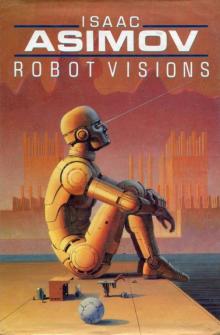 Robot Visions
Robot Visions Lucky Starr And The Moons of Jupiter
Lucky Starr And The Moons of Jupiter Lucky Starr and the Big Sun of Mercury
Lucky Starr and the Big Sun of Mercury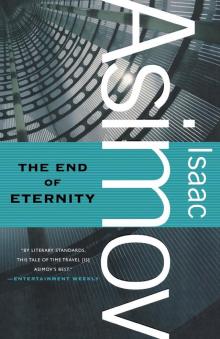 The End of Eternity
The End of Eternity The Bicentennial Man and Other Stories
The Bicentennial Man and Other Stories Lucky Starr And The Rings Of Saturn
Lucky Starr And The Rings Of Saturn Buy Jupiter and Other Stories
Buy Jupiter and Other Stories Forward the Foundation
Forward the Foundation Lucky Starr and the Oceans of Venus
Lucky Starr and the Oceans of Venus The Positronic Man
The Positronic Man The Portable Star
The Portable Star Asimovs Mysteries
Asimovs Mysteries Earth Is Room Enough
Earth Is Room Enough The Gods Themselves
The Gods Themselves Youth
Youth The Early Asimov Volume 3
The Early Asimov Volume 3 The Winds of Change and Other Stories
The Winds of Change and Other Stories Of Time, Space, and Other Things
Of Time, Space, and Other Things Nine Tomorrows
Nine Tomorrows Time Warps
Time Warps Robots and Empire
Robots and Empire Young Star Travelers
Young Star Travelers Fantastic Voyage II: Destination Brain
Fantastic Voyage II: Destination Brain Second Foundation
Second Foundation The Rest of the Robots
The Rest of the Robots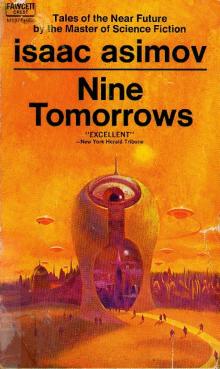 NINE TOMORROWS Tales of the Near Future
NINE TOMORROWS Tales of the Near Future Daneel Olivaw 1 - The Caves of Steel
Daneel Olivaw 1 - The Caves of Steel THE BICENTENNIAL MAN
THE BICENTENNIAL MAN David Starr Space Ranger (lucky starr)
David Starr Space Ranger (lucky starr) David Starr Space Ranger (ls)
David Starr Space Ranger (ls) Lucky Starr And The Big Sun Of Mercury ls-4
Lucky Starr And The Big Sun Of Mercury ls-4 Pebble In The Sky te-1
Pebble In The Sky te-1 Asimov’s Future History Volume 9
Asimov’s Future History Volume 9 Gold: The Final Science Fiction Collection
Gold: The Final Science Fiction Collection Foundation and Earth f-7
Foundation and Earth f-7 Asimov's New Guide to Science
Asimov's New Guide to Science STORM OVER WARLOCK
STORM OVER WARLOCK Stars, Like Dust
Stars, Like Dust Norby The Mixed-Up Robot
Norby The Mixed-Up Robot Found!
Found! Asimov’s Future History Volume 11
Asimov’s Future History Volume 11 Second Foundation f-5
Second Foundation f-5 Asimov’s Future History Volume 15
Asimov’s Future History Volume 15 The Early Asimov. Volume 1
The Early Asimov. Volume 1 Secound Foundation
Secound Foundation Daneel Olivaw 3 - The Robots of Dawn
Daneel Olivaw 3 - The Robots of Dawn Asimov’s Future History Volume 6
Asimov’s Future History Volume 6 The Early Asimov. Volume 2
The Early Asimov. Volume 2 Lucky Starr And The Rings Of Saturn ls-6
Lucky Starr And The Rings Of Saturn ls-6 100 Malicious Little Mysteries
100 Malicious Little Mysteries Forward the Foundation f-2
Forward the Foundation f-2 I.Asimov: A Memoir
I.Asimov: A Memoir Foundation's Edge f-6
Foundation's Edge f-6 Lucky Starr and the Pirates of the Asteroids ls-2
Lucky Starr and the Pirates of the Asteroids ls-2 Robot City 1 & 2
Robot City 1 & 2 The Fourth Science Fiction Megapack
The Fourth Science Fiction Megapack Asimov’s Future History Volume 16
Asimov’s Future History Volume 16 The Dim Rumble
The Dim Rumble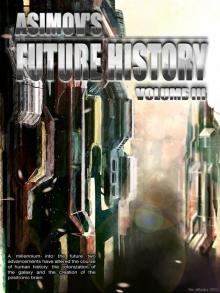 Asimov's Future History Volume 3
Asimov's Future History Volume 3 The Currents Of Space te-3
The Currents Of Space te-3 Asimov’s Guide To Shakespear. Volume 1
Asimov’s Guide To Shakespear. Volume 1 Asimov’s Future History Volume 13
Asimov’s Future History Volume 13 Asimov’s Future History Volume 12
Asimov’s Future History Volume 12 The Secret Sense
The Secret Sense Of Time and Space and Other Things
Of Time and Space and Other Things Norby tnc-2
Norby tnc-2 Norby The Mixed-Up Robot tnc-1
Norby The Mixed-Up Robot tnc-1 Misbegotten Missionary
Misbegotten Missionary Asimov’s Future History Volume 19
Asimov’s Future History Volume 19 Fantastic Voyage II: Destination Brain fv-2
Fantastic Voyage II: Destination Brain fv-2 Asimov’s Future History Volume 10
Asimov’s Future History Volume 10 Asimov's Future History Volume 2
Asimov's Future History Volume 2 Feeling of Power
Feeling of Power In the Beginning
In the Beginning The Caves of Steel trs-1
The Caves of Steel trs-1 Asimov's Future History Vol 2
Asimov's Future History Vol 2 Caliban c-1
Caliban c-1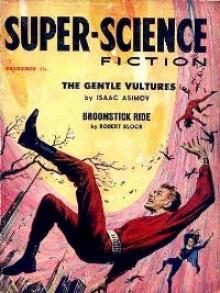 The Gentle Vultures
The Gentle Vultures Utopia c-3
Utopia c-3 Prelude to Foundation f-1
Prelude to Foundation f-1 Short Stories Vol.1
Short Stories Vol.1 Asimov’s Future History Volume 8
Asimov’s Future History Volume 8 Daneel Olivaw 4 - Robots and Empire
Daneel Olivaw 4 - Robots and Empire Lucky Starr The And The Moons of Jupiter ls-5
Lucky Starr The And The Moons of Jupiter ls-5 Gold
Gold Asimov’s Future History Volume 4
Asimov’s Future History Volume 4 Foundation and Empire f-4
Foundation and Empire f-4 Potential
Potential Asimov’s Future History Volume 14
Asimov’s Future History Volume 14 Asimov’s Future History Volume 7
Asimov’s Future History Volume 7 Daneel Olivaw 2 - The Naked Sun
Daneel Olivaw 2 - The Naked Sun Lucky Starr and the Pirates of the Asteroids
Lucky Starr and the Pirates of the Asteroids Foundation f-3
Foundation f-3 All the Troubles of the World
All the Troubles of the World Cleon the Emperor
Cleon the Emperor Asimov's Future History Volume 5
Asimov's Future History Volume 5 Asimov’s Future History Volume 20
Asimov’s Future History Volume 20 Robots and Empire trs-4
Robots and Empire trs-4 Profession
Profession It's Been a Good Life
It's Been a Good Life The Robots of Dawn trs-3
The Robots of Dawn trs-3 Lucky Starr And The Oceanf Of Venus ls-3
Lucky Starr And The Oceanf Of Venus ls-3 The Naked Sun trs-2
The Naked Sun trs-2 Asimov's Future History Volume 1
Asimov's Future History Volume 1